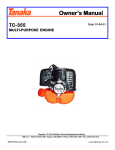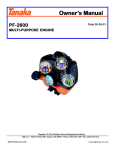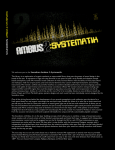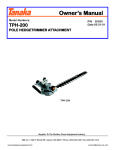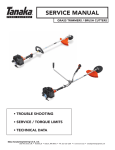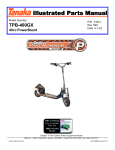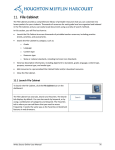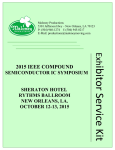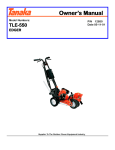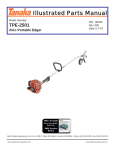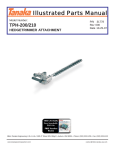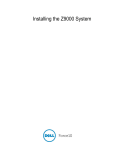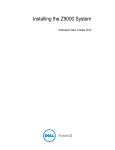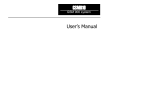Download Tanaka TOB-120 User's Manual
Transcript
Owner’ s Man ual Owner’s Manual Model Numbers: TOB-120,TOB-300 P/N 25153 Date 05-19-01 OUTBO ARD MO TORS OUTBOARD MOT TOB-120 TOB-300 Supplier To The Outdoor Power Equipment Industry ISM, Inc. • 1028 4th Street SW • Auburn, WA 98001 • Phone: (253) 333-1200 • Fax: (253) 333-1212 www.tanakapowerequipment.com [email protected] TOB-120,TOB-300 Owner’s Manual A Message to Tanaka Customers Welcome to the world of Tanaka equipment. We are pleased that you have purchased the best equipment available. The care you give your Tanaka equipment will determine the satisfaction and service life you will obtain from it. Use this manual as your guide. By observing the instructions and suggestions in this manual, your Tanaka equipment will serve you well for many years. Your Tanaka dealer will be happy to supply any service or advice which may be required to keep your Tanaka equipment operating at peak efficiency. He stocks genuine Tanaka parts and lubricants; manufactured with the same precision and skill as the original equipment. His factory trained staff is kept well informed on the best methods of servicing Tanaka equipment and is ready and able to serve you. If service is required, be prepared to supply the service person with the Model and Serial Number of the equipment, as well as a full description of the problem encountered. NOTE: The descriptions and specifications contained in this manual were in effect at the time the manual was approved for printing. Tanaka Kogyo Co., Ltd. reserves the right to discontinue models without notice and without incurring obligation. The equipment described within this manual may not be identified as either standard or optional and the various illustrations may not all be applicable to your particular unit. If you have questions, always check with your Tanaka dealer. Safety Alert Symbol And Notations The following safety notations are used throughout this manual to call attention to special information or operating procedures. Understand the message in each notation and be alert to unsafe conditions and the possibility of personal injury. NOTE: IMPORTANT: Points out general reference information regarding proper operation and maintenance practices. Statement indicates specific procedures or information that is required to prevent damage to the machine or its attachments. This safety alert symbol is used to attract your attention! PERSONAL SAFETY IS INVOLVED! When you see this symbol - BECOME ALERT - HEED ITS MESSAGE. CAUTION: Identifies safe operating practices or indicates unsafe conditions that could result in personal injury. WARNING: Describes a condition where failure to follow the instructions could result In severe personal injury. DANGER: Designates a condition where failure to follow instructions or heed warning will most likely result In serious personal Injury or death. WARNING The engine exhaust from this product contains chemicals known to the State of California to cause cancer, birth defects and other reproductive harm. www.tanakapowerequipment.com 1 [email protected] TOB-120,TOB-300 Owner’s Manual Instructions contained in this manual apply to models listed on this page. Use the instructions that apply to your unit. Models Model………… TOB 120 Outboard Motor Model………… TOB 300 Outboard Motor Specific Model Number and Serial Number of your equipment are on a label on the unit. Record numbers below and use them whenever parts or service are required. Model Number - ____________________________ Serial Number - ____________________________ Engine Serial Number - ____________________________ Safety Precaution - ____________________________ Safety Precautions Read and understand this Owner's Manual before operating this unit. Be thoroughly familiar with controls and proper use of equipment. Know how to stop unit quickly in an emergency. This Outboard Motor is a quality marine product designed to give years of dependable service when operated and maintained properly. If rotating propeller comes in contact with your body, it will cause severe personnel injury. If blade comes in contact with submerged hard objects, it may damage blade. Be aware of sudden lifting of motor leg and propeller out of the water which may occur if an underwater object is struck. Understand and follow each Danger, Warning, Caution and instruction decals installed on equipment or described in this manual. Use only replacement parts designed for this unit. See your Tanaka Dealer for a complete list. Although some unauthorized parts may appear to be adaptable, their use may be extremely dangerous and could cause serious personal injury. This is especially true of propellers which may be of poor construction or improperly balanced. NEVER allow children to operate or play with unit. DO NOT allow adults to operate unit without proper instructions. Anyone using this unit must understand the information in this manual. Safe operation of this equipment requires complete and unimpaired attention at all times. DO NOT operate unit if fatigued, during or after consumption of medication, drugs or alcohol. When transporting unit in a vehicle, secure it to prevent it from sliding or tipping over which could cause damage to your unit or spill fuel. www.tanakapowerequipment.com 2 [email protected] TOB-120,TOB-300 Owner’s Manual Safety Precautions cont. Preparation NEVER allow smoking materials, sparks or flame (match, pilot light, etc.) near unit or gasoline container. Thoroughly inspect Outboard Motor for damage, chipped propellers, fuel leaks, etc. before operating this unit. Check fuel supply before starting motor. Always start boating trips with a full tank. NEVER attempt to make any adjustments to unit while motor is running (except where specifically recommended). DO NOT fill fuel tank indoors, when motor is running or while motor is still hot. Wipe off any spilled gasoline, allow vapors to dissipate and move fuel container 10 feet (3m) away from unit before starting motor. Gasoline is highly flammable and its vapors are explosive. Handle with care. Use an approved (RED) gasoline container. Operation Keep equipment in good condition. Keep all guards and shields in place and safety devices operating properly. Never allow swimmers or waders near unit while it is in operation. The operator is responsible for the safety of swimmers and boaters in the area. Be sure that Throttle Lever stops motor when moved to stop position and Lever moves freely. On units equipped with Stop button, be sure button stops unit. After mounting motor on transom, set proper motor trim according to size and weight of the boat. See Tilt Adjustment in Operation section of this manual. Exhaust fumes contain carbon monoxide, an odorless and deadly gas. DO NOT run motor in enclosed or poorly ventilated areas. Move Throttle Lever to stop position to stop propeller. Always keep a fire extinguisher in the boat along with life vests and other U. S. Coast Guard approved safety equipment. Before starting, make sure unit is properly secured to boat transom using clamp stud handles. Be sure a safety chain, from unit to boat, is installed. Check clamp handles for tightness periodically. Before attempting to make any adjustment, repairs, inspections or cleaning unit, stop motor, wait for moving parts to stop, allow unit to cool then remove wire from spark plug . Always carry a spare propeller, shear pins, hair pins, spark plug and necessary repair tools such as pliers, screwdriver, and wrenches. If equipment vibrates abnormally during operation, stop motor at once, wait for moving parts to stop, and remove wire from spark plug. Abnormal vibration is a warning of trouble. Repair any damage before restarting unit. (See your Tanaka Dealer.) When starting unit, be sure propeller is clear of all objects because when motor is started, throttle may be set high enough to rotate the propeller. After motor is started and idling smoothly, propeller must not rotate. DO NOT operate unit if propeller rotates when motor is idling. After striking a submerged object, stop motor, wait for moving parts to stop, then remove wire from spark plug. Thoroughly inspect unit for any damage. Repair damage before restarting and operating unit. DO NOT put hands or other body parts near rotating parts. Before shutting motor off, after operating under full load for an extended period, lower motor speed and allow it to idle for a few minutes so that motor parts can cool evenly. Maintain a firm hold on the twist grip at all times to help keep control of the unit. Operate equipment only when there is good visibility and light. www.tanakapowerequipment.com In the event of an emergency, stop the motor by moving Choke Lever to full choke position. 3 [email protected] TOB-120,TOB-300 Owner’s Manual Safety Precautions cont. Boating, Trailering and Auxiliary Use Tips When trailering this unit, secure motor in an upright (vertical) position against boat transom. Do not trailer with unit tilted up. If unit must be transported while tilted up, place a suitable brace, such as a 2 x 4, between motor bracket and motor leg. Tie down motor leg against brace to prevent damage to motor leg. When transporting unit in a vehicle, secure it to prevent turnover which could result in spilled fuel or damage to unit. To prevent fuel leakage from the carburetor when unit is tilted, close vent screw on fuel tank, turn off fuel shut off valve, and allow unit to run at idle until it stops. Take all possible precautions when leaving unit unattended. Remove and keep wire away from spark plug to prevent accidental starting or unauthorized use. When loading boat, distribute weight evenly to prevent tipping. Keep heavy loads low in the boat. Do not stand up in a small boat. Standing, bow riding, seat back and gunwale riding can be dangerous. When loading or launching a boat on a trailer, tilt motor up to prevent propeller from striking ramp or underwater objects. An auxiliary adjustable position motor bracket is recommended when using unit as auxiliary power for watercraft. Maintenance and Storage Periodically check that Throttle Lever stops motor when moved to stop position and Lever moves freely. Periodically check operation of propeller clutch brake. Propeller should stop almost immediately when throttle is fully released. DO NOT operate unit if brake does not operate properly. Have unit serviced by your Tanaka dealer before operating. Discard propellers that are broken or damaged in any way. Replace only with Tanaka original equipment replacement parts for safety. Keep all nuts, bolts and screws tight and be sure equipment is in safe working condition. Check all hardware at regular intervals. NEVER store unit with gasoline in tank inside a building where fumes may reach an open flame or spark. Allow motor to cool before storing in any enclosure. www.tanakapowerequipment.com 4 [email protected] TOB-120,TOB-300 Owner’s Manual Preparation for Operation WARNING: Failure to follow all instructions could result in personal injury and/or damage to unit. Remove wire from spark plug before attempting any adjustment or assembly procedures. Instructions contained in this manual apply to several models. Use the instructions that apply to your unit. Fuel Mixture IMPORTANT: 2-cycle engines require that oil be mixed with fuel. Refer to Fuel in Operation section of this manual for recommended mixture. Handle Assembly Model 120 Place handle (throttle lever up) into position on joint pipe holder with notch on end of handle against handle stopper. Secure to joint pipe holder with wing head bolt, lock washer, two plain washers, and Hair Pin. Attach throttle cable to carburetor bracket. Model 300 Place handle (throttle cable down) into position on clutch case. Be sure flat of handle is set in notch of handle stopper. Secure to clutch case with 8 x 30 bolt, lock washer, and two plain washers. Attach throttle cable to carburetor. Gear Housing Check gear housing for proper level of grease prior to operation. See Lubrication and Maintenance section for proper procedures. www.tanakapowerequipment.com 5 [email protected] TOB-120,TOB-300 www.tanakapowerequipment.com 6 Owner’s Manual [email protected] TOB-120,TOB-300 Owner’s Manual Operation PRE-STARTING IMPORTANT: 2-cycle engines require that oil be mixed with gasoline (refer to Fuel section below for proper mixture). CAUTION: Make sure all hardware is tight, all safety devices are in place and operating, all adjustments are made correctly, that Stop Switch on models equipped with them, stops motor and that Throttle Lever moves freely. Fuel IMPORTANT: Failure to mix oil with gasoline will result in seizure and severe damage to motor. DO NOT use gasohol or gasoline containing alcohol because alcohol will attack and cause internal parts to deteriorate. Use unleaded gasoline for best performance. NOTE: To prevent foreign particles from entering tank while filling: wipe dust, dirt and debris from around cap before removing it. WARNING: Gasoline is highly flammable and must be handled with care. Allow motor to cool several minutes before removing fuel tank cap. Never fill tank when motor is running or hot from operation. Do not allow open flame, matches, or smoking in area. DO NOT overfill. Wipe up any spills and allow vapors to dissipate. Use approved (Red) gasoline container. Tanaka 2-cycle oil has been formulated to insure maximum motor performance and increased motor life. Premix Tanaka oil per instructions on container. If Tanaka oil is not available, select a quality 2-cycle approved oil and use unleaded gasoline. If oil manufacturer does not recommend a specific mixing ratio, mix at a 1 to 50 ratio (2.6 ounces oil per gallon of unleaded gasoline). Always use branded 89 octane unleaded gasoline. NOTE: After fuel mixture has been left standing for a prolonged period of time it will begin to separate, therefore thoroughly shake mixture before using. Mounting To Boat Motor must be mounted in center of boat transom. Recommended transom height is 20". Clamp to transom with clamp stud handles turned hand tight. Secure unit to transom using a safety chain (not supplied). During operation, occasionally check clamps for tightness. Loose clamps may result in damage to motor or boat. www.tanakapowerequipment.com 7 [email protected] TOB-120,TOB-300 Owner’s Manual Tilt Adjustment Motor tilt must be adjusted to propel boat through the water with an even keel. If the motor is tilted too far outward, bow of the boat would ride too high in the water obscuring the operator's view and be susceptible to sudden movement by high winds and waves. If the motor is tilted too far inward, the bow may dig into high waves or wakes. A 12 to 15 degree tilt is recommended. This angle may need to be adjusted according to the weight of boat and passengers. Improper transom height or tilt angle may result in boat "porpoising" or motor cavitation. Boat porpoising is a condition where the bow of the boat raises and falls rapidly and continuously. Motor cavitation is a condition where turbulent air passes by the propeller resulting in an increase in motor speed coupled with a rapid drop in boat speed. These conditions can also be caused by fast turns, rough water, wrong or obstructed propeller, or poor boat design. To adjust, stop motor and allow propeller to come to a full stop. Tilt motor all the way up to the storage position, then remove Tilt Lock Bracket Pin. Re-position lock pin in one of five angle adjustment holes in clamp bracket. Secure Tilt Lock Pin with Hair Pin. To determine the best motor tilt angle, start with the Tilt Lock Adjustment Pin in the center set of holes. In calm water, operate boat at full throttle with a normal load. Adjust tilt angle as necessary to establish a near even keel. Steering Adjustment The amount of resistance to movement of the steering handle is adjustable. Loosen or tighten the steering tension bolt using an open end spanner wrench (supplied). IMPORTANT: The tension bolt may fall out if loosened much. www.tanakapowerequipment.com 8 too [email protected] TOB-120,TOB-300 Owner’s Manual STARTING CAUTION: DO NOT attempt to start motor at this time. Familiarize yourself with controls to see what they do, how they work and thoroughly read and understand entire Owner's manual first. WARNING: Insure all guards and safety devices are installed and working properly before starting. WARNING: Rotating propeller can cause serious Injury. Be sure propeller is clear of swimmers, waders, or underwater objects because when Throttle is set at starting position motor speed will be fast enough for clutch to engage and propeller to rotate. Fuel When starting motor, open Air Vent Screw on Fuel Filler Cap. Open Fuel Shut Off Valve. Choke If starting a cold motor, move Choke Lever to its START (ON) position. After motor begins to fire, move choke lever to its RUN (OFF) position. IMPORTANT: Continued over choking while engine is running may cause spark plug to foul. Flooding is a condition where motor will not start due to an overabundance of fuel in crankcase. If flooding occurs, move choke lever to RUN position, set throttle at half and pull rewind starter handle until engine starts and continues to run. Throttle Lever Model 120 Move Throttle lever to a half open position. Model 300 Move twist grip handle to half throttle position. WARNING: Starting motor may Immediately engage propeller clutch resulting In a sudden movement of the boat. Be sure all passengers are seated before starting motor. NOTE: Allow motor to warm up at idle speed for 2 to 3 minutes before applying load. WARNING: After motor Is started and Is Idling smoothly, propeller must not rotate. A rotating propeller can cause severe personal Injury. See Adjustment Section for Carburetor Adjustment. www.tanakapowerequipment.com 9 [email protected] TOB-120,TOB-300 Owner’s Manual Rewind Starter Grasp Rewind Starter handle and pull rope slowly until you feel some resistance, then pull rope with a rapid stroke and allow rope to rewind slowly. Repeat above instructions until motor starts. CAUTION: Never start motor at full throttle or stand up while starting motor. WARNING: When motor starts, propeller may start to rotate at a high rate of speed. Reduce Throttle speed Immediately. Failure to do so may result In loss of control of the boat and may cause severe personal Injury. IMPORTANT: If motor does not stop immediately when Stop Button is depressed, move Choke Lever to its OFF (closed) position to stop motor. Have Stop Button serviced before restarting unit. IMPORTANT: Do not release starter rope and let it snap back against housing. STOPPING IMPORTANT: If motor will not be used for long periods of time, tilt motor up to storage position, or removed from boat. The following procedures should be used to prevent fuel spillage. 1) Close fuel shut off valve. 2) Close air vent on fuel fill cap. 3) Allow motor to run until it stops on its own. For normal stopping, move Throttle Lever or twist grip to IDLE position and allow motor to run at idle speed for a few minutes so that motor parts can cool evenly. To shut off, move Throttle Lever to full OFF position. For model 300, depress Stop Button. CAUTION: Remove wire from spark plug to prevent accidental starting or unauthorized use of unit. Salt Water Operation Operation in salt water will result in accumulation of salt or mineral deposits on exposed motor parts. To prevent corrosion of motor, take the following steps. Set unit upright to drain water. Remove spark plug and pour 2 ounces of oil in plug hole. Install plug but not plug wire. Set motor upright and pull recoil starter rope rapidly 2 or 3 times to distribute oil over internal surfaces. Have unit serviced as soon as possible Always tilt motor out of the water when not in use. Never leave lower unit in salt water overnight. Rinse exterior of unit with fresh water and wipe dry. Apply a thin coating of oil over unit. Inspect unit daily and apply a light coating of grease to components which show signs of corrosion. Always tilt motor by lifting on rear of shroud. Do not push down on handle. Operation after Submersion A motor which has been entirely submerged in water must be completely disassembled and cleaned before operation. Disassembly should be done by a certified Tanaka technician. To avoid corrosion of internal parts, this should be accomplished as soon after recovery as possible. If certified Tanaka service is not immediately available, proceed as follows. www.tanakapowerequipment.com 10 [email protected] TOB-120,TOB-300 Owner’s Manual Lubrication and Maintenance Maintenance, replacement, or repair of the emission control devices and systems may be performed by any non-road engine repair establishment or individual. Your Tanaka Dealer will be happy to provide any service required to keep your Outboard Motor operating at peak efficiency. CAUTION: Stop motor, wait for moving parts to stop and disconnect spark plug wire before attempting any lubrication or maintenance procedures. CAUTION: DO NOT touch motor or drive parts which might be hot from operation. Allow such parts to cool before servicing unit. Shear Pin Replacement Insure that motor has stopped, wire from spark plug is removed, and unit has cooled down. A shear pin through the propeller shaft is designed to prevent damage to the drive train if the propeller strikes an underwater object. The shear pin will not prevent damage to the propeller which may also require replacement after striking an object. When the pin is sheared, motor will continue to run but the boat will stop movement. Shut off motor immediately to prevent damage to unit. To replace shear pin, remove cotter pin which holds propeller against shear pin. Remove propeller and inspect for damage. Replace if necessary. Lubricate shaft with lithium grease. Shaft should be lubricated every 30 to 60 days. Inspect gear case for damage and have serviced if necessary. Replace broken shear pin and reassemble propeller and cotter pin. Fuel Filter Model 120 Fuel filter is located just above fuel shut off valve knob. To remove filter, turn valve OFF. Remove fuel inlet bolt just above knob. Rinse inlet screen and bolt assembly in warm water with detergent. Rinse thoroughly several times until all traces of detergent are eliminated. Allow assembly to air dry before re-installing. Model 300 Turn fuel shut off valve to OFF position. Unscrew sediment bowl, then remove 0-ring and screen from valve and clean as described above for model 120. www.tanakapowerequipment.com 4 [email protected] TOB-120,TOB-300 Owner’s Manual Motor Cooling The motor is air cooled, and air must circulate freely around motor and over cooling fins on cylinder head to prevent overheating. Once a year or every one hundred (100) operating hours, more often if conditions require) clean fins and external surfaces of motor of dust, dirt and oil deposits which can contribute to improper cooling. IMPORTANT: DO NOT operate motor with motor shroud or muffler guard removed as this will cause overheating and motor damage. Spark Plug Spark plug should be cleaned or replaced (if necessary) and gap reset to .023" (.6 mm) every 100 hours of operation or yearly whichever comes first. To clean, remove any oil or dirt from area around spark plug base, remove spark plug from motor. In a smooth running motor, plug will have brown colored electrodes. Scrape and wash with a commercial solvent. Allow to air dry. Do not sand blast clean. NOTE: Arcing can occur if wire terminal does not fit firmly on spark plug. Reform or replace terminal as needed. Test for faulty ignition system by removing spark plug from engine. Connect plug wire and hold plug electrode against bare metal part of motor (away from spark plug hole). Pull recoil starter rope several times. If spark jumps gap of electrode, ignition system is in good condition. Muffler Muffler and exhaust pipe direct noise and motor exhaust under water. Periodically check muffler and pipe for proper operation and carbon buildup. Disassemble and clean out carbon buildup if necessary. Replace if damaged. CAUTION: Worn out or corroded mufflers are dangerous. Continued use could result In loss of hearing, fire or explosion. Gear Housing Check gear housing for proper level of grease after first 4 hours of operation and every 50 hours thereafter. See Storage section for annual maintenance. To check and fill unit with gear oil, pull motor out of the water and place in an upright position. Remove spark plug wire. Remove housing drain plug and washer. Insert nozzle of lubricant tube fully into hole and squeeze tube until excess oil flows from around nozzle. Replace plug and washer. Tighten securely. NOTE: Use 90 weight Hypoid Gear Oil. www.tanakapowerequipment.com 12 [email protected] TOB-120,TOB-300 Owner’s Manual Adjustments Carburetor IMPORTANT: To prevent damage to carburetor, have idle adjustment performed by an trained professional. Tanaka company recommends that you take your unit to your Tanaka dealer when these adjustment are necessary. Model 120 Carburetor has a fixed high speed jet screw which is preset at factory and does not need adjustment. Model 300 Carburetor is preset at the factory, however, due to weather changes or after extended use it may require idle adjustment. WARNING: Accurate carburetor adjustment must be made with motor running. The propeller will spin during carburetor adjustment. Stay clear of propeller at all times and observe all safety instructions. To adjust carburetor, start motor using proper starting procedures, and allow unit to run a few minutes to reach operating temperature. Move Twist Throttle Grip handle all the way off, to idle position. Turn IDLE adjustment screw clockwise to increase motor speed, counter-clockwise to decrease motor speed. When idle speed is properly set, propeller should not rotate and motor will continue to run. Model 300 incorporates an automatic duel clutch design which allows the propeller to rotate very slowly or stop completely when motor is idling. A sub clutch engages at slow speeds and the main clutch engages at approximately 6 MPH. Model 120 utilized a direct drive system. Storage reinstall cover and refill with grease as described under Lubrication and Maintenance. Store unit in an upright position on a sturdy stand. Your authorized Tanaka Dealer is trained and equipped to service your unit. A periodic checkup by your dealer will help reduce your maintenance costs. Pull recoil starter rope until a slight resistance is felt then slowly release rope. At this point, the piston is covering intake an exhaust ports of the chamber. If Tanaka 2-cycle oil is not used, we recommend stabilization of the fuel with an anti-oxident fuel stabilizer, such as Sta-Bil", a product of Gold Eagle Co. Follow directions on the product label. Otherwise the fuel should be drained before storage. Run motor out of fuel as described in Operation Section. Clean unit thoroughly. Touch up all areas to prevent rust. Inspect unit for visible signs of wear, breakage or damage. Order any parts required and make necessary repairs to avoid delays when beginning use again. Drain gear housing and refill with new lubricant to remove moisture and prevent possible corrosion of internal parts. To drain, remove propeller and shear pin. Remove gear housing cover. Drain grease, www.tanakapowerequipment.com Cover unit and store it in a dry moisture free area. 13 [email protected] TOB-120,TOB-300 www.tanakapowerequipment.com 14 Owner’s Manual [email protected]















